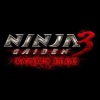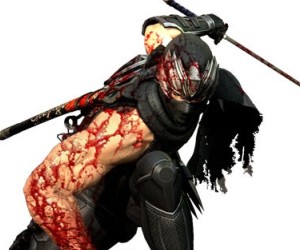 Game: Ninja Gaiden 3: Razor’s Edge
Game: Ninja Gaiden 3: Razor’s Edge
Developer: Team Ninja
Publisher: Tecmo Koei & Nintendo
Available on: Wii U only
In the words of Deus Ex: Human Revolution’s Adam Jensen: If you want to make enemies, try to change something. It’s a lesson Team Ninja learned hard in March last year when Ninja Gaiden 3 launched on the Xbox 360 and PlayStation 3 to a chorus of angry cursing, spittle-soaked derision and one dagger-in-the-ribs 3/10 courtesy of IGN. Team Ninja were accused of making too many changes and removing too many of the series’ core elements in order to pander to the masses. The few good scores it earned (even managing an 8 here or there) were quickly forgotten, and the developers knew they needed to pull something special out of the bag if they were to produce a game worthy of the Wii U’s launch line-up. Somehow, Ninja Gaiden 3: Razor’s Edge delivers. As an enhanced port of the original, it doesn’t address and correct every issue, but the difference is substantial enough to allow Razor’s Edge to stand alongside Ninja Gaiden 2 and feel part of the family.
STORY: Ninja Gaiden 3: Razor’s Edge is a story about guilt, mostly. Anyone who has played the last two instalments will know that protagonist Ryu Hayabusa (of Dead or Alive fame) is somewhat partial to procedural dismemberment. He has never met a bad guy he didn’t slice into tiny squibs, and has never shied away from a nice relaxing bloodbath. He’s the sort of man to whom brutal mass-murder is somehow therapeutic, tearing through private military goons and enemy ninja with nary a thought for the hopes and dreams of the men and women he’s eviscerating in the name of justice.
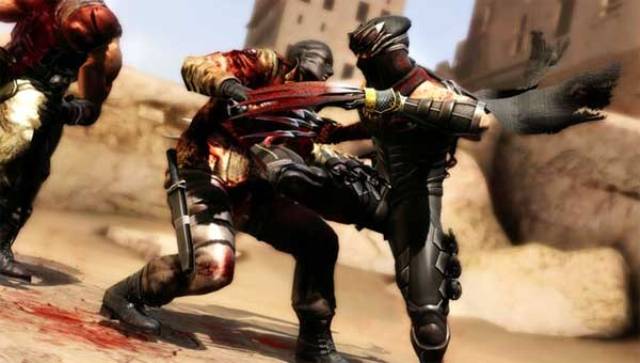
However, now it would appear that all the years of wanton bloodlust have caught up with our brooding hero and, whilst responding to a terrorist threat in London, he finds himself cursed with the Grip of Murder. Despite the slightly hammy name, the Grip of Murder is a bit more serious than a bout of flu, causing Ryu to absorb his infamous Dragon Sword into his right arm along with the tortured souls of everyone he’s skewered with it. It’s all down to the nefarious Regent of the Mask, a Jack of Blades-looking pantomime villain in a red robe who’s every bit as handy with a Samurai sword as Ryu himself.
From here the narrative follows a mostly linear path, taking in black magic and terrorism and several sizeable plot twists as Ryu faces of against the Lords of Alchemy, an international cell comprised of sorcerers and demons and about 11,000 soldiers with dodgy cockney accents. It’s fair to say that Ninja Gaiden 3: Razor’s Edge won’t win any awards for storytelling, but the fast-paced plot and Ryu’s personal stake in the fate of the world is more than enough to keep you playing, even if you will occasionally wonder why a man cursed with pain and suffering by the souls of his countless victims keeps on adding to the pile instead of just jacking it all in and retiring to somewhere quiet.
GRAPHICS: As with all of Team Ninja’s efforts, Razor’s Edge is a great looking game. There’s a particular art style associated with the rebooted Ninja Gaiden series (and Dead or Alive) that we’ve come to expect, and Razor’s Edge doesn’t let the side down. There’s not much between this version and the other format editions in terms of visuals, but it’s worth pointing out that the Wii U matches the other consoles move for move with no visible slowdown or pop-in, and no lag even when you’re carving your way through upwards of 10 enemies with rockets whizzing by, explosions going off and screen-filling Ninpo attacks eating up the scenery.
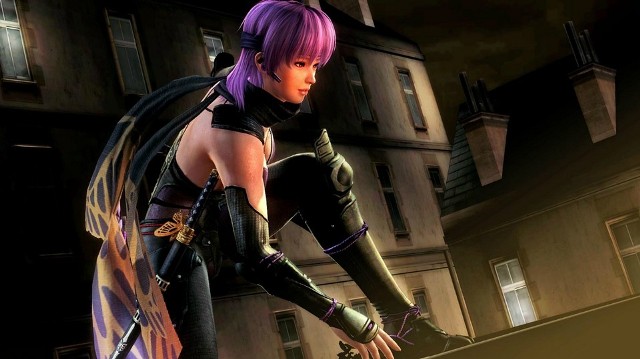
Character models are a little lacklustre at times, however, with most of the work obviously going into Ryu, the Regent of the Mask and Ryu’s sidekick and confidante Mizuki. Enemies are horribly identikit, and you’ll often find yourself fighting 8 or more soldiers with only three different models between them. It’s mind-numbing to look at and incredibly lazy on Team Ninja’s part. In previous games (and parts of this one) where you’re up against enemy ninja or robed sorcerers, having every one dressed the same isn’t a problem, but when they are supposed to be mercenary soldiers, a little variety wouldn’t go amiss.
SOUND: If you’re expecting much more from Razor’s Edge than angry J-Rock and dodgy voice-acting, you’re probably playing the wrong game. Ninja Gaiden is not a series renowned for its sound direction, scored mostly in manly grunts, screams of terrible agony and the wet, squelchy sound of a very sharp sword having a quiet word with some very soft flesh. Razor’s Edge follows suit impressively well, offering few moments that will linger in your aural memory once you put down the pad.
The voice work is ok for the most part, but the standard enemies have an infuriating habit of spitting the same looped expletives out in the same terrible British accent over and over during any given fight. At certain points I was tempted to simply turn the voice volume all the way down and play with only sound effects and music, although the battle music isn’t much more palatable.
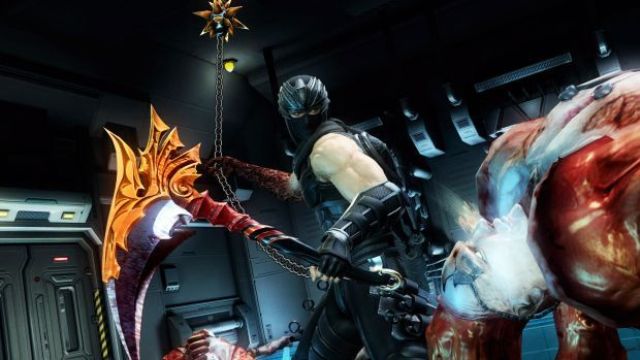
GAMEPLAY: I’ve never seen a port – even an enhanced one – with so much added to it as this. Team Ninja have clearly listened to the criticisms (and more importantly, the genuine gripes of established fans) and acted upon them. As a result, Razor’s Edge is an incredibly complete package and returns to a position far closer to Ninja Gaiden 2 than the previous version could boast. The first major change is the increased difficulty. Even on Hero mode (otherwise known as Easy), it can be hard to keep Ryu alive, particularly in the early stages before you’ve increased your repertoire of skills and upgraded your combat stats a little. Playing on Ninja mode is a veritable nightmare even for the seasoned. It’s clear that even with the added touches and huge amount of extra content, this is still not Ninja Gaiden 2, and the precision and poise needed to succeed in that game is simply not necessary here. Razor’s Edge remains very much a button masher, which is a shame because Team Ninja have tried hard to remove that stigma from this enhanced version.
The problem is that even with improved AI, enemies are ridiculously relentless in their assault. The foot soldiers go freaking nuts spamming the same unblockable grab-and-explode moves, while ranged enemies have an unlimited supply of rockets with which to lay down an absolute barrage of fiery death. You’ve got the tools and the moves to make mincemeat of any number of enemies in a balanced fight, but the combat pacing is so off-kilter as a fallout from the original version’s lack of grace, that attempts to readdress it now have only been partly successful. The key move in each battle is the Bone on Steel technique, whereby you time Ryu’s counter attack to instantly kill an enemy before chaining together kill combos to take down several foes in quick, bloody succession. It’s not as precise or as varied as it needs to be, but it makes the larger fights manageable and looks pretty cool at the same time.
Thankfully, though, Ryu has a lot more tricks at his disposal this time around. Reintroducing Ninja Gaiden 2’s Karma score system (XP-gathering by any other name), Team Ninja bring back a level of depth and control to Ryu’s development, allowing for upgradeable health, unlockable moves and new costumes. Series fans will be happy to hear that the single Ninpo move has been replaced by four new abilities that will still wipe out large numbers of enemies and heal Ryu, but which allow for more variety. Likewise, Ryu is not restricted to swords, as the Tiger Claws and Scythe (among other things) can also be found and equipped. Rather than simple re-skins, these weapons come with their own combo lists, special animations and bloody finishers.
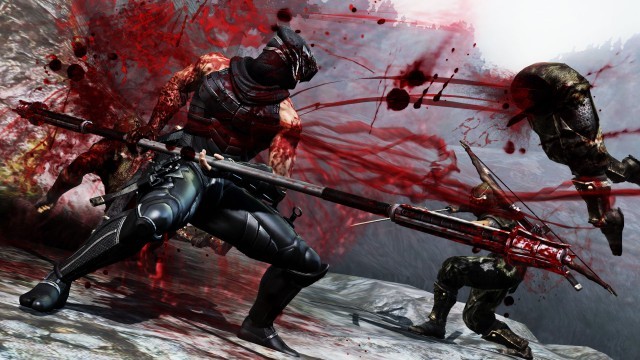
Speaking of which, Ninja Gaiden 2’s trademark dismemberment is back and more graphic than ever before. Apparently Team Ninja’s claim that “people don’t want to see that anymore” was about as accurate as saying “men don’t like boobies”. The internet was upset when Ninja Gaiden 3 shipped sans limb removal and, as puerile and gratuitous as it may be, it just feels right that it’s back now. With the Grip of Murder it becomes even more blood-drenched; kill enough enemies and Ryu’s arm will glow, at which point holding down X will activate the equivalent of an Ultimate Technique and obliterate whichever poor souls are in its way.
At certain moments, Ryu will start clutching the arm and be dragged into a weird alternate dimension resembling a craggy, barren plain. Once there, enemies will throw themselves at you with gleeful, lemming-like abandon and all you’ll have to do is dice them to pieces to proceed. If these moments offered anything even slightly different to to the standard encounters, they would have a point. Unfortunately, every fight in Razor’s Edge is in an enclosed space that you can’t leave until every surface is dripping with blood and viscera. You feel at all times as though you’re simply moving through a series of rooms, even when you’re halfway up an abandoned skyscraper or in the middle of a burning jungle. Walk ten paces, climb a wall, get trapped and kill everyone, then rinse and repeat. Boss battles will always follow a set pattern, which may be the status quo but is still a little tedious. The linearity and repetition of each mission is the biggest upset in Razor’s Edge, and truly holds back what might have been considered a great game.
The last big addition – or comeback, as the case may be – is the inclusion of Tests of Valor, those bastard-hard on-the-spot challenges you’ll only find on normal mode or above that pit you against waves of enemies and force you to use everything at your disposal to survive. All are replayable from the main menu, so you can keep chasing that elusive perfect score. Stealth is an element inexplicably overlooked for the whole trilogy – Ryu is a Ninja, and Ninja’s should be silent, catlike, graceful, not slaughtering insurgents by the bus-load in the middle of the street – but with the kunai climb and the ability to kill an enemy unaware returning from vanilla Ninja Gaiden 3, there’s at least something approaching stealth.
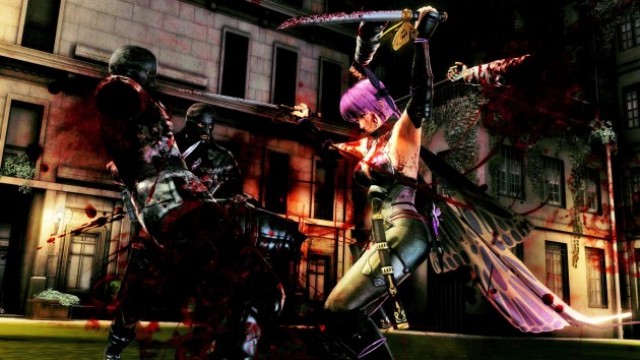
At two certain points you’ll switch characters and play as the purple-haired Ayane (also a DoA alumni). Her missions are shorter than Ryu’s but no less bloody, and she controls almost identically. Her move-set is slightly different but, apart from her breasts, she’s no major departure from the norm. All her presence really does is extend the game a little and offer a brief, ever-so-slightly indulgent view of an animated chick in just a towel.
The GamePad integration is solid, either displaying a combo list and quick buttons for Ninpo, skills and weapon changes or converting to a mini game screen for that handheld feel. The smaller screen loses nothing of the big-screen splendour, and in fact makes it a little easier to keep an eye on what’s going on during the more frenzied fights. Despite the GamePad making it far faster to activate Ninpo and cycle through Ryu’s brutal arsenal, I found myself playing on the smaller screen more and more throughout the game, though I did have to disable the overused rumble feature within the first hour.
MULTIPLAYER: The online element of Razor’s Edge is a strange beast, offering a small selection of modes to experiment with. The first is the Ninja Trials mode, which you’ll unlock after meeting certain conditions in the solo game. In this mode you can either play alone or in co-op with another player and tackle specific challenges designed to test your skill or, if playing in tandem, your teamwork. Clan Battles is a more straightforward affair, pitting two teams of four ninja against one another in a team deathmatch scenario. As I reviewed the title prior to release I was unable to fully test the multiplayer mode, but did have a quick fiddle with the customisation options which, with nothing yet unlocked, were pretty sparse. Having only two modes and little variety – at least on the face of it – the multiplayer component (the first to ever feature in a Ninja Gaiden game) is unlikely to trouble the big names, but may offer something fresh and intriguing to fans.
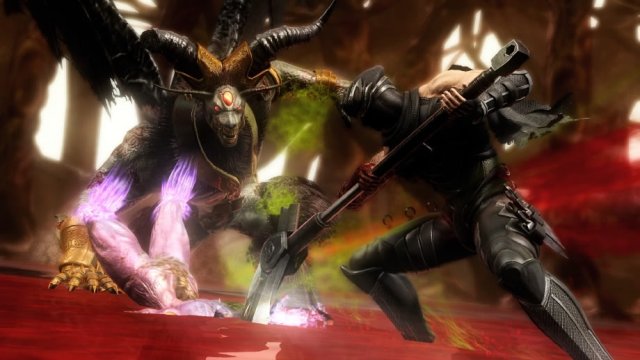
LONGEVITY: Topping off at around 10 hours, Ninja Gaiden 3: Razor’s Edge is exactly long enough. It’s testament to Team Ninja that even despite my complaints about the repetitive nature of the combat, I never became bored with either the story or the gameplay. Exploring each level (you can only wander a few feet off the beaten path each time) to find the 50 hidden golden scarabs is worth the time as they unlock new weapons and skills, and the Tests of Valor will challenge you for hours if you want to truly beat each one. Taking into consideration the multiplayer, and Razor’s Edge starts to look more and more like value for money, even if you played the less-than-stellar original. You can even go back and play every mission as Ayane if you choose to, though you’ll find very little changed.
VERDICT: You’ve got to hand it to Team Ninja here, really. The original was a mess created out of a desire to take something hardcore and make it appeal to the wider market. Nothing hardcore should ever be diluted for anyone’s sake, that’s the whole point of it being hardcore. But with Razor’s Edge, Team Ninja go some way to redeeming themselves, packing in the gore, the extra challenges, a variety of weapons and Ninpo, character progression, more protagonists and a multiplayer mode to boot.
Ryu will face some stiff competition on the other platforms over the next month or two, but on Wii U there’s nothing else like Razor’s Edge to satisfy the hardcore bloodlust of Ninja Gaiden fans. Saying that this is the best version of a bad game is no praise at all, so instead I’ll put a pin in the original version for a moment and simply say that, judged on its own merit, Ninja Gaiden 3: Razor’s Edge is an enjoyable hack ‘n’ slash action game that might not manage the once-lofty heights of its predecessors, but still does the Wii U, Team Ninja and established followers of the franchise proud.



